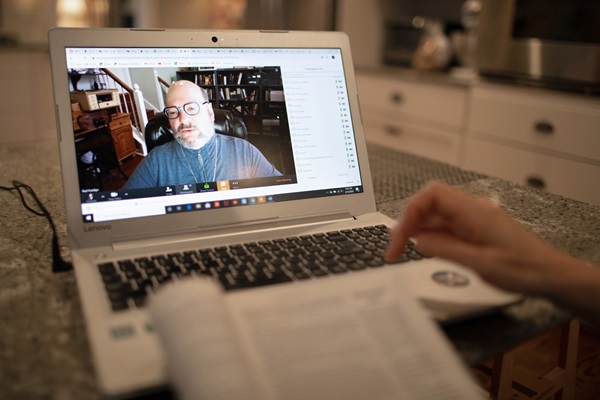The coronavirus pandemic has quickly changed the social landscape for millions around the world. When our usual routines are interrupted and people cannot meet face-to-face, congregations can find creative ways to connect members and communities in prayer, worship, and ministry.
Transitioning church life and ministry to online and virtual gatherings will take time. There will be a learning curve and bumps along the road as people engage and connect in unfamiliar ways. Be patient, non-anxious, and offer plenty of grace to yourselves as leaders and to one another.
Implementing digital technologies will help your church be in ministry during any emergency situations that impact in-person contact. Here are a few tips and resources to help you plan for each area of ministry.
WORSHIP
- Keep it simple. If you’re a novice with online worship, there are ways to do it without a lot of technical knowledge or professional equipment.
+ Taking your worship online: A guide for beginners and everyone else
+ 5 Important Tweaks to Make to Your Online Church Service This Sunday
+ Use Facebook Live to stream your church events
+ Webinar: Livestreaming Using What You Have
+ Local Church Learning Session: Live Streaming Your Worship Service on Facebook
- Worship well and wisely. Use this growing list new resources for home-based worship from United Methodist and ecumenical worship leaders and scholars.
+ Christian Worship and Devotion during Social Distancing: (Ministry Matters)
- Get the appropriate licenses to legally livestream copyrighted music, liturgy or other content.
+ Ask The UMC: How can we livestream worship legally?
+ Local Church Learning Session: Copyrights + Licenses
+ Music and Worship resources for livestreaming
+ Webinar: Copyright Laws webinar series
- Publicize online worship services on your church’s website, sign, social media and phone message. Extend invitations to the community through all of these channels.
+ Communicating changes in worship
+ Where to worship online
- Encourage electronic giving options.
+ Local Church Learning Session: eGiving + Connectional Giving
+ Quickly find an online giving solution for your church
+ Adding donations option to a church’s Facebook page
+ Understand electronic giving
+ 10 Ideas for Church Financial Leaders Amid the COVID-19 Crisis
+ Electronic recurring giving
SMALL GROUPS
- Discipleship classes, Bible study groups, prayer teams and other small groups can utilize technology to continue distance learning.
+ Local Church Learning Session: Getting Started with Zoom for Worship and Small Groups
+ Webinar: Using Digital Technologies for Faith Formation
+ Zooming to small groups during Lent
+ Making the Most of Online Small Groups
+ Amplify Media Free Resources (a streaming service launched by the United Methodist Publishing House)
+ Adult Bible Studies (limited permissions from the United Methodist Publishing House)+ Children’s resources
+ Cokesbury Kids Free Resources
+ Helping children during the COVID 19 crisis
+ Resources to connect socially distanced youth
- Prayer groups – Prayer teams can use older technology (phones or email) or new ways (Zoom) to continue the ministry of prayer. Be sure to provide information on your church website and social media about how people can request prayer. Include a place to indicate whether the prayer request is confidential or can be shared with a prayer group or the congregation.
Choose a virtual meeting format for prayer group members which allows group members to join from any device. Those without computers, mobile devices or reliable internet can still participate by phone. Members need to be aware of others nearby who may see or hear the prayer requests. Send a return email, text or card (if possible) to let those requesting prayer know that prayers have been offered on their behalf.
+ Centering prayer for anxious times
+ A senior’s prayer for coronavirus
+ A prayer calendar to focus your days
COMMITTEES
- Virtual meeting technologies allow church leaders to continue planning and monitoring the ministries and administration of the church. Set up Dropbox or a similar system where various group and ministry reports can be kept and accessed by council members and ministry leaders.
For those committees or topics that require meeting in closed session, virtual meetings may not be advisable. Some decisions require votes taken in an in-person meeting by the members present.
+ Virtual meeting platforms help churches stay on track during the COVID-19 pandemic
+ Five Tips for Managing Your Church Budget During the COVID-19 Crisis
CARE MINISTRIES
- Caring for members - During emergencies, it’s important to be more intentional and proactive about checking in on people. Many churches regularly use phone trees and group emails to reach members. Consider setting up “check-in groups” of 4-5 individuals or families who receive at least one personal call per week from the group leader.
+ Chuck Knows Church: Things We Can Do video series
+ 10 guidelines for pastoral care during the coronavirus outbreak
+ Resources for Spiritual Wellness in Anxious Times
- Caring for the community - While church buildings are closed for worship and other groups, community needs continue and likely have increased. Check with your conference office or foundation about grants for new or existing programs, such as food pantries, transportation needs and support for shut-ins and other requests for assistance.
+ Holston Foundation Coronavirus Emergency Response Grant
TECHNOLOGY AND TRAINING
- Short training sessions help guide you on setting up virtual groups quickly.
+ Local Church Learning Session: Getting Started with Zoom for Worship and Small Groups
+ Local Church Learning Session: Live Streaming Your Worship Service on Facebook
+ Zoom for churches
+ Ministry through Facebook groups
+ Virtual meeting platforms help churches stay on track during the COVID-19 pandemic
+ Online and Virtual Gatherings: Inclusion for Deaf and Hard-of-Hearing Members
CONNECTIONAL AND CLERGY QUESTIONS
This content was produced by Ask The UMC, a ministry of United Methodist Communications.





